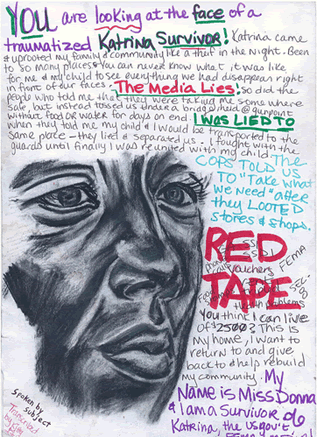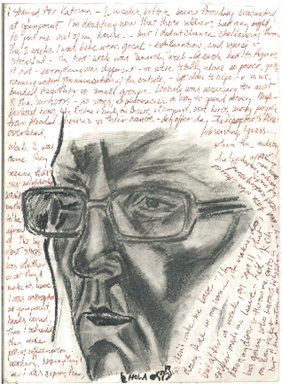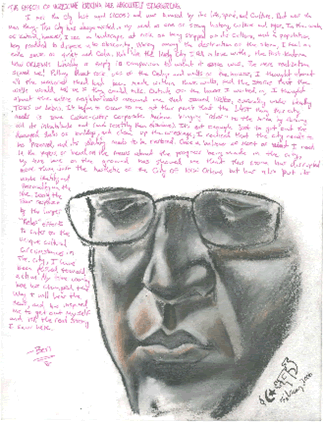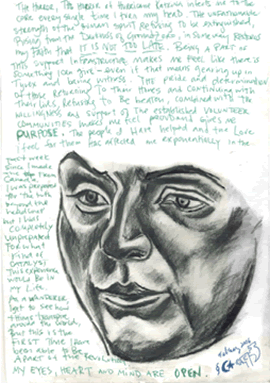Cultural and Collective Trauma
Mon. November 19, 2007Categories: Papers
Although the hurricane dealt a real blow, Hurricane Katrina itself was not the single most dramatic event for those in the Ninth Ward. In reality, the trauma was what took place after the winds died down: the abandonment of an entire community, even if just for a few days, as rescue efforts were delayed and, in some cases, blocked.
This essay sees the similarity between our government’s response to Hurricane Katrina and systemic repressions in South America. I discuss the labors of memory and frame those labors in the context of Freudian and Jungian theories. Finally, I examine the idea of the cultural complex as it relates to cultural trauma.
The written narratives were scribed as the rubble cleared. These stories are important to read in order to maintain objectivity in the face of media ‘spin.’ The stories reveal layers of crisis. At times, it felt like there were two storms: the one the media reported and the one that the survivors narrated. The artist’s concern was to hear the stories from those most impacted by the disaster, meanwhile the process was a methodology for the performance of identity during crisis. The stories serve as “knowledge objects”. The portrait artist writes,
“I began this collection of voice and memory with an understanding that any event or movement consists “only” of all the individual lives composing it, regardless of how drastic or large, regardless of all the grand, sweeping relevancy it may boast. . . .Aware of history as a social construct I decided it would exist most honorably if constructed with the direct intent of those living it. . .Whether one looks through one or many strains of history and claims they are full of truths or full of lies, we remain nonetheless, un-absolved from the reality of history’s continuous unfolding throughout our lives. History, like any social norm or institution, when it fails to provide satisfaction or accountability before the public it serves or is a part of, becomes a whole ordeal, subject to instability, reconstruction or abolition by a questioning populism, disaffection or transformation.” (di Santis, 2006)
We can agree that history is a social construction whose infrastructure contains cultural traumas, sometimes known and sometimes disguised. Perhaps the definitions that follow will be useful.
Cultural traumas are the disruption of a way of life shared by people in a similar place or time. They are not only a mild disturbance to the equilibrium of people who share attitudes, values, goals, and practices, these traumas can be experienced as a ‘shock’ to the psyche.
Collective trauma, on the other hand, may be so subtle that the masses do not see it happening, especially when it goes under-reported, if at all. Whether it is a devastating drought, raging fires, overflowing rivers, a tsunami, or a pandemic, these physical events also contain non-physical traumas. In both cases of cultural and collective trauma, not everyone will have a similar reaction to the same event.
Why is that?
It has something to do with identity. Group consciousness is a product of narratives and of relations around the construction of race, class, gender, and sexuality, whether through political philosophy, religious ideals, or various social agendas, regardless whether or not these constructions are true. When the word ‘identity’ is used as a verb, it becomes an on-going performance, that is, an identity act. Survivor stories reflect the performance of identity during crisis. However, they are not the only ones to struggle because in the act of reading these portrait stories many people experience doubts about one’s idea of their self in relation to a culture that allows this trauma to happen. But if readers of these narratives choose to, they can also perform identity acts as the meanings are absorbed. This activity holds the possibility of changing thoughts, feelings, and beliefs.
For people in the Ninth Ward, trauma has left an indelible mark on their consciousness and memories. The mechanisms of psychological defense for collective trauma is similar to individual trauma. The mechanism for both is repression instead of “activating direct cognition and rational understanding of the traumatizing event” (Alexander, 2004, p. 5). In NOLA, the struggle is between the need to name what took place and the government’s understatement of what took place. To this end, I will also discuss collective trauma “therapy” which has as its aim the restoration of collective psychological health by lifting societal repression and restoring memory (Alexander, 2004, p. 7). It is through trauma narratives that collective identity can be strengthened, especially during crisis. These narratives play into the way we construct history: through our memories.
The act of re-constructing cultural traumas is to “cognitively identify the existence and source of human suffering” and assume some responsibility for it (Alexander, 2004, p. 1). The portrait stories unconsciously cause us to question our own identities, i.e., that we still live in a country ruled by “race” and “class” ideologies. This is the only explanation I can find for the reason why, as I plastered a wall with portraits, only 15% of my privileged classmates could bring themselves to read about the disastrous repressions. One classmate said it was too difficult to try and make any sense of what had happened. I was stunned that these were my cohort studying liberation psychology. Especially since “social scientists stress the importance of finding through public acts of commemoration, cultural representation, and public political struggle – some collective means for undoing repression and allowing the pent-up emotions of loss and mourning to be expressed” (Alexander, 2004, p. 7). Although a challenge to our collective identity, representations of cultural repression in public spaces could promote compassion for human suffering.
“I stayed for Katrina – two weeks before being forcibly evacuated at gunpoint. I doubt now that those soldiers had any right to put me out of my house, but I didn’t chance challenging them. The two weeks I was here were great! Exhilarating and scary and stressful. The first week was anarchy week. We each had to figure it out – everything was different, we were totally alone: no power, gas, running water, communication with the outside, left alone to cope and so we banded together in small groups. Looting was necessary for most of the survivors – no stores, no pharmacies, no way to spend money. Neighbor-hood heroes were saving people from flooded houses in their canoes day after day. Helicopters flew overhead observing, I guess. Week two was when the military came. They helped after seeing our neighborhood wasn’t anything to be afraid of. The biggest stress was whether or not they’d make us leave. I was interrogated at gunpoint, hands raised, then I befriended them, made pots of coffee every morning, hoping they’d see I was coping fine. “So don’t make me leave, I am doing fine in my home, I’m making do” but a week after September 11th that soldier made me leave. He kicked down my door and threw me onto a bus going who knows where with a one-way ticket but I had gasoline so I drove away and those who stayed went underground, hid out. I was gone three weeks, back now…”
The State’s response has been to take actions that would lead to an increase in the median income and the tax base in the Ninth Ward and surrounding parishes. This is done through administrative repression by state representatives (Althusser, 1995, p. 110). Ideological state apparatuses like the press, radio, and television (p.111) justify ‘cleaning up’ the Ninth Ward by imagining being low-income is bad (or poor people are bad), thereby giving implicit support to repressive state apparatuses like the National Guard to force people out of their housing even when that housing was undamaged by the storm. The State Apparatus in today’s world sees its primary purpose as economic progress through free market capitalism. What is being reproduced under free market capitalism, besides “political dynasties, military dynasties, etc.” (Althusser, 1995, p.114) are homeland security dynasties that require disasters. How are ordinary citizens going to deal with disasters when we have a “weak, under-funded, ineffective public sector on the one hand, and a parallel richly-funded corporate infrastructure on the other? (Klein, 2007, p. 409).
In the future, disaster responders and the independent media may not have access inside disaster zones for the production of narratives since these areas will be more tightly controlled. When that happens, we will not have portrait stories such as these to reflect first hand accounts of human suffering and joy. Free market ideologies do not consider identity anything less than an impediment to economic progress unless there is profit attached. If access was denied after the hurricane these portraits would never have been drawn, these stories not written so close to the actual event. The disaster capitalism complex of the future will block access and we know who will benefit from that, Not the most vulnerable – not the poor. Naomi Klein describes a particular day in New Orleans after the storm in her book Shock Doctrine,
“The news racing around the shelter that day was that Richard Baker, a prominent Republican congressman from this city [New Orleans] had told a group of lobbyists, “We finally cleaned up public housing in New Orleans. We couldn’t do it, but God did.” Joseph Canizaro, one of New Orleans wealthiest developers, had just expressed a similar sentiment: “I think we have a clean sheet to start again, and with that clean sheet we have some very big opportunities.” All that week the Lousiana State Legislature in Baton Rouge had been crawling with corporate lobbyists helping to lock in those big opportunities: lower taxes, fewer regulations, cheaper workers, and a ‘smaller, safer city’ – which in practice meant plans to level public housing projects and replace them with condos. ” (Klein, 2007, p. 4)
The politicians and developers reported that it was an act of God which drove people from their homes with no guarantee of return! The State and Feds are possibly in the process of institutionalizing disaster in a way that makes any subsequent diaspora appear natural. Natural? Doesn’t Natural Law gives people the right to dignity, equality, and justice? It is not natural to be deprived of food, clothing, and shelter.
“The morning Hurricane Katrina came through I did not know the hurricane was passing because living in public housing helped a lot. The buildings are strong and the electricity did not go out until 6:00 a.m. that morning. The winds blew and I asked is that really the hurricane because I didn’t feel it. After the hurricane was over the water started to creep up step by step and I could not figure out where the water came from. It’s a mystery about that water because it came after the hurricane. I left my house 4 o’clock Wed evening and was placed on six-10 interstate where I stayed until I went to Houston, Texas. While I was on the bridge pepper spray was sprayed in the crowd by Louisiana State police. It was in my eyes and throat. When I arrived in Houston I was dehydrated and placed on I.V. medicine. My blood pressure was elevated. Public housing saved many lives during the storm and therefore it should be opened. I am ready to go home, and many more are ready to go home, too. God Saved Public Housing and it should be opened. People need places to stay. Open public housing soon, its time to come home. I want to live in my city and that’s New Orleans. I’m temporarily living in Baton Rouge. ” Chantel Young.
Repressive state apparatuses also lead us to disregard what we have seen or heard, thus shaping our memories. Not only that, we are willing to ignore that which threatens our identity . . . we erase memory of the disaster, of the war, of the event that led to the trauma. Media folklorists, on the other hand, have the responsibility to reproduce memories during the unfolding of history, in other words, they are memory entrepreneurs. We should all question the State as regards our collective memory.
In terms of history, I believe we can correlate the government’s response in New Orleans to systemic repressions in Argentina, Uruguay, Chile, Brazil, Paraguay, Bolivia and Peru that we read about in State repression and the Labors of Memory by Elizabeth Jelin (2003). That is because the hurricane did for our government what military dictators have accomplished around the world as they’ve attempted to revitalize their economies.
“THE EFFECTS OF HURRICANE KATRINA ARE ABSOLUTELY STAGGERING. I met the city last April (2005) and was amazed by its life, spirit, and culture. That was the main thing. This city has always existed in my mind as one of strong history, culture and vigor. In the wake of Katrina, however, I see a landscape at risk of being stripped of its culture, and a population being prodded to disperse into obscurity. Working among the destruction of the storm, I feel an eerie sense of grief and calm. Not like the lively city I fell in love with, the Post-Katrina New Orleans literally is empty in comparison to what it once was. The mere realization scared me! Pulling sheet rock off of the ceilings and walls of the houses, I thought about all the memories that had been made within these walls, and the stories that the walls would tell us if they could talk. Outside of the houses I worked in, I thought about the entire neighborhoods around me that seemed lifeless, suffocating under literally tons of debris. It began to occur to me at this point that the last thing this city needs is some cookie-cutter corporate machine bringing “relief” to the area by forcing all its inhabitants out (and resettling them elsewhere). It’s not enough just to gut out the damaged shells of buildings, and clean up the wreckage, I realized that the city needs to be preserved, and its identity needs to be restored. Once a believer or most of what I read in the papers, or heard on the news about the progress being made in the city, my time here on the ground has shown me that this storm has disrupted more than just the aesthetic of the city of New Orleans, but has also put its whole identity and personality in the (?). Seeing the poor response by the (?) relief efforts to cater to the unique cultural circumstances in the city, I have been pushed toward action. My time working here has changed the way I will hear the news, and has inspired me to get out myself and tell the real story I saw here.” – Ben
Jelin (2003) says that democratic protests under military dictatorships in South America involved confrontations, police violence, the loss of civil rights, systematic institutional discrimination, and the constraint of economic and social rights… (pp. xvi-xvii). Sound familiar?
Charmaine L. Marchand, a State Representative for Louisiana from the Ninth Ward, says the population went from 32,000 before the storm to approximately 1,200 people living in the lower 9th today. “Red Tape” is the answer she gave when asked why the area has not been rebuilt, i.e., “a shortfall of Road Home money” and “too much mitigation money for demolition which they could not allocate because waivers were not granted” (KPFK radio interview, 2007). She blames the delay on huge administrative costs in yet another demonstration of administrative repression. Others said it is the choice of who to protect and which areas to preserve.
Jelin’s research makes it easier for me to see commonalities between past and present narratives across cultures, countries, and hemispheres. Although her book “seeks to contribute some tools to think about and analyze the presences, silences, and meanings of the past” (p. xv), Jelin’s discussion carefully distances the reader from understanding the economic reasons for State repression while elaborating on the nature of memory itself and its relationship to identity.
If we can see-through disaster, war, pandemic, or conflict to the root economic causes, then we can more easily survive and retain identity. But we do not always have the privilege, ease, or luxury of understanding why things happen as they unfold. That is the purpose of research, of truth commissions, of courts.
Our job, the labor of memory, is to attend to memories that “disrupt, penetrate, or invade the present” in order to prevent ritualized repetition (Jelin, 2003, pp.5-6); in other words, to make an effort to remember the past in order to reconstruct identity in such a way that we do not repeat the trauma. In therapy, working through our memories allows us to “let go” so as not to be preoccupied by attachment to painful memory. This labor of memory includes the Freudian notion of overcoming resistance to an interpretation and accepting it (Jelin, 2003, p.6).
From the perspective of lay trauma theory, I argue that traumatic memories could be viewed symbolically, i.e., the storm as a mythic battle between opposing forces. We are all heroes and villains. How do we envision our struggle in these terms? Consciously forming a dialectic allows us to attain critical distance. We can empathize with the hero and the villain both by using active imagination to feel into the opposites. One method includes feeling to the edges (or boundaries) of our experience. We identify our feelings by naming them and then flip to the opposite (we gain flexibility in seeing ourselves as both the hero and the villain). In actual practice, this is difficult to do, that is, to feel to the edges of an opposite…what is it like to embrace the hero in our story followed by our embrace of the villain? When we develop the flexibility to feel into both sides of the polarity, the result will be synthesis. As the polarities synthesize within active imagination, the conflict within our identity dissolves. You could call it a Jungian labor of memory. Transcending opposites is common at the core of many world mythologies and religions. I call this “becoming undivided in light of a repression”. In Jungian theory, this is a lifetime process and is referred to as individuation:
“The horror, the horror of Hurricane Katrina infects me to the core every single time I turn my head. The unfathomable strength of the human spirit refusing to be extinguished, rising from the darkness of ground zero, in some way restores my faith that it is not too late. Being a part of this support infrastructure makes me feel like there is something I can give – even if that means gearing up in Tyrex and bearing witness. The pride and determination of those returning to their homes and continuing with their lives, refusing to be beaten, combined with the willingness and support of the established volunteer communities makes me feel proud and gives me purpose. The people I have helped and the love I feel for them has affected me exponentially in the past week since I made the trip from Canada. I was prepared for the truth beyond the headlines but I was completely unprepared for what kind of catalyst this experience would be in my life. As a wanderer, I get to see how things transpire around the world but this is the first time I have been able to be a part of the revolution. My eyes, heart and mind are open.” (Anonymous volunteer, 2006)
“New Orleans opened herself up to me with a warm heart and begged for…no, welcomed my soul. The people, the music, the very life of the great city consumed me. All the devastation and pain that I saw was but an opportunity to heal. To heal people and a city in pain, but also to heal my selfish heart.” (Anonymous, 2006)
“The streets have been washed off of all meaning. Among all this rubble, the only action that seems possible is to create. Humans recognize contrast and within destruction we are performing the only thing we know to do: build. Yes, more disasters will come. But that’s not the point. ” (Anonymous).
What Jelin says is needed are interviewers and social spaces of listening committed to “preservation” of the remnants and traces of the past embedded in life experience, but much more than that: a keen awareness of the subjective experience of the people who are invited to narrate their life experiences. (Jelin, 2003, p. 66). The Post Katrina Portrait Story Project provided the presence of empathetic listeners to hear anguished memories, and it affirmed and recognized their realness.
References
Alexander, J., Eyerman, R., Giesen, B., Smelse, N., Sztompka, P. (2004). Cultural trauma and collective identity. Berkely, CA: University of California Press.
Allen, G. (2003). Roland Barthes. New York, NY: Routledge.
Althusser, L. (1995). Mapping Ideology. In S. Zizok (Ed.), Ideology and ideological state apparatuses (notes towards an investigation) (p. 101-139). Scranton, PA: WW Norton/National Book Company.
Blackburn, T. (2007). Post Katrina Portraits blog. http://blog.postkatrinaportraits.org
Culler, J. (2002). Barthes: A very short introduction. Oxford, England: Oxford University Press.
Di Santis, F. (2006). Post Katrina Portrait Project. Retrieved September 4, 2007 online from http://www.postkatrinaportraits.org
Eyerman, R. (2001). Cultural trauma: Slavery and the formation of African American identity. New York, NY: Cambridge University Press.
Jelin, E. (2003). State repression and the labors of memory. Minneapolis, MN: University of Minneapolis Press.
Klein, N. (2007). The shock doctrine: The rise of disaster capitalism. New York, NY: Metropolitan Books/Henry Holt & Co. LLC.
Marchand, Charmaine L. The Courtyard radio broadcast. Saturday, November 10, 2007. KPFK 90.7 FM.
Singer, T. & Kimbles, S. L. (2004). Analytical Psychology: Contemporary Perspectives In Jungian Analysis. In J. Cambray & L. Carter (Eds..), The emerging theory of cultural complexes (p. TBD-TBD). New York, NY: Brunner-Routledge.
SuperCom LTC. 24 Sept. 2007. Vuance. Retrieved online 12 Nov. 2007 http://www.supercom-inc.com/emergency_management.php




